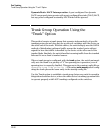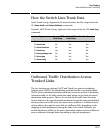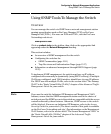
Port Trunking
Trunk Group Operation Using the “Trunk” Option
Dynamic/Static LACP Interoperation: A port configured for dynamic
LACP can properly interoperate with a port configured for static (TrkX) LACP,
but any ports configured as standby LACP links will be ignored.
Trunk Group Operation Using the
“Trunk” Option
This method creates a trunk group that operates independently of specific
trunking protocols and does not use a protocol exchange with the device on
the other end of the trunk. With this choice, the switch simply uses the SA/DA
method of distributing outbound traffic across the trunked ports without
regard for how that traffic is handled by the device at the other end of the
trunked links. Similarly, the switch handles incoming traffic from the trunked
links as if it were from a trunked source.
When a trunk group is configured with the trunk option, the switch automati-
cally sets the trunk to a priority of “4” for spanning-tree operation (even if
spanning-tree is currently disabled. This appears in the running-config file as
spanning-tree Trkn priority 4. Executing write memory after config-
uring the trunk places the same entry in the startup-config file.
Use the Trunk option to establish a trunk group between a switch covered in
thisguide and another device, where the other device’s trunking operation fails
to operate properly with LACP trunking configured on the switches.
12-26


















